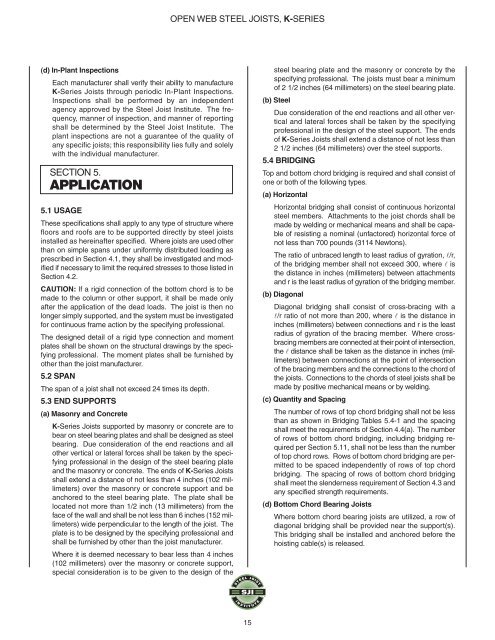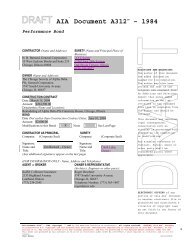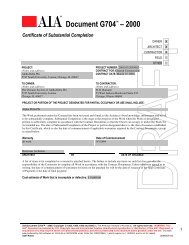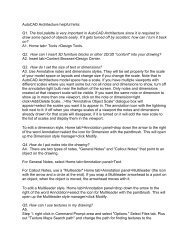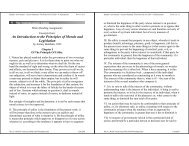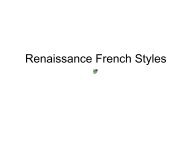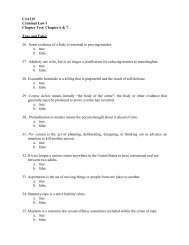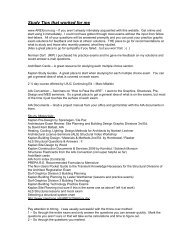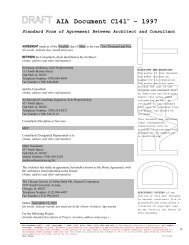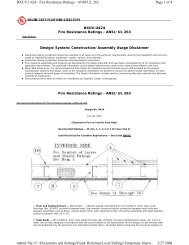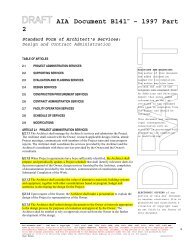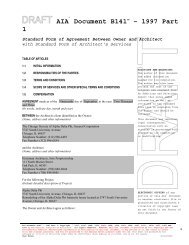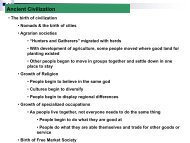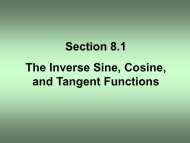Steel Joist Manual
Steel Joist Manual
Steel Joist Manual
Create successful ePaper yourself
Turn your PDF publications into a flip-book with our unique Google optimized e-Paper software.
OPEN WEB STEEL JOISTS, K-SERIES<br />
(d) In-Plant Inspections<br />
Each manufacturer shall verify their ability to manufacture<br />
K-Series <strong>Joist</strong>s through periodic In-Plant Inspections.<br />
Inspections shall be performed by an independent<br />
agency approved by the <strong>Steel</strong> <strong>Joist</strong> Institute. The frequency,<br />
manner of inspection, and manner of reporting<br />
shall be determined by the <strong>Steel</strong> <strong>Joist</strong> Institute. The<br />
plant inspections are not a guarantee of the quality of<br />
any specific joists; this responsibility lies fully and solely<br />
with the individual manufacturer.<br />
SECTION 5.<br />
APPLICATION<br />
5.1 USAGE<br />
These specifications shall apply to any type of structure where<br />
floors and roofs are to be supported directly by steel joists<br />
installed as hereinafter specified. Where joists are used other<br />
than on simple spans under uniformly distributed loading as<br />
prescribed in Section 4.1, they shall be investigated and modified<br />
if necessary to limit the required stresses to those listed in<br />
Section 4.2.<br />
CAUTION: If a rigid connection of the bottom chord is to be<br />
made to the column or other support, it shall be made only<br />
after the application of the dead loads. The joist is then no<br />
longer simply supported, and the system must be investigated<br />
for continuous frame action by the specifying professional.<br />
The designed detail of a rigid type connection and moment<br />
plates shall be shown on the structural drawings by the specifying<br />
professional. The moment plates shall be furnished by<br />
other than the joist manufacturer.<br />
5.2 SPAN<br />
The span of a joist shall not exceed 24 times its depth.<br />
5.3 END SUPPORTS<br />
(a) Masonry and Concrete<br />
K-Series <strong>Joist</strong>s supported by masonry or concrete are to<br />
bear on steel bearing plates and shall be designed as steel<br />
bearing. Due consideration of the end reactions and all<br />
other vertical or lateral forces shall be taken by the specifying<br />
professional in the design of the steel bearing plate<br />
and the masonry or concrete. The ends of K-Series <strong>Joist</strong>s<br />
shall extend a distance of not less than 4 inches (102 millimeters)<br />
over the masonry or concrete support and be<br />
anchored to the steel bearing plate. The plate shall be<br />
located not more than 1/2 inch (13 millimeters) from the<br />
face of the wall and shall be not less than 6 inches (152 millimeters)<br />
wide perpendicular to the length of the joist. The<br />
plate is to be designed by the specifying professional and<br />
shall be furnished by other than the joist manufacturer.<br />
Where it is deemed necessary to bear less than 4 inches<br />
(102 millimeters) over the masonry or concrete support,<br />
special consideration is to be given to the design of the<br />
steel bearing plate and the masonry or concrete by the<br />
specifying professional. The joists must bear a minimum<br />
of 21/2 inches (64 millimeters) on the steel bearing plate.<br />
(b) <strong>Steel</strong><br />
Due consideration of the end reactions and all other vertical<br />
and lateral forces shall be taken by the specifying<br />
professional in the design of the steel support. The ends<br />
of K-Series <strong>Joist</strong>s shall extend a distance of not less than<br />
2 1/2 inches (64 millimeters) over the steel supports.<br />
5.4 BRIDGING<br />
Top and bottom chord bridging is required and shall consist of<br />
one or both of the following types.<br />
(a) Horizontal<br />
Horizontal bridging shall consist of continuous horizontal<br />
steel members. Attachments to the joist chords shall be<br />
made by welding or mechanical means and shall be capable<br />
of resisting a nominal (unfactored) horizontal force of<br />
not less than 700 pounds (3114 Newtons).<br />
The ratio of unbraced length to least radius of gyration, l/r,<br />
of the bridging member shall not exceed 300, where l is<br />
the distance in inches (millimeters) between attachments<br />
and r is the least radius of gyration of the bridging member.<br />
(b) Diagonal<br />
Diagonal bridging shall consist of cross-bracing with a<br />
l/r ratio of not more than 200, where l is the distance in<br />
inches (millimeters) between connections and r is the least<br />
radius of gyration of the bracing member. Where crossbracing<br />
members are connected at their point of intersection,<br />
the l distance shall be taken as the distance in inches (millimeters)<br />
between connections at the point of intersection<br />
of the bracing members and the connections to the chord of<br />
the joists. Connections to the chords of steel joists shall be<br />
made by positive mechanical means or by welding.<br />
(c) Quantity and Spacing<br />
The number of rows of top chord bridging shall not be less<br />
than as shown in Bridging Tables 5.4-1 and the spacing<br />
shall meet the requirements of Section 4.4(a). The number<br />
of rows of bottom chord bridging, including bridging required<br />
per Section 5.11, shall not be less than the number<br />
of top chord rows. Rows of bottom chord bridging are permitted<br />
to be spaced independently of rows of top chord<br />
bridging. The spacing of rows of bottom chord bridging<br />
shall meet the slenderness requirement of Section 4.3 and<br />
any specified strength requirements.<br />
(d) Bottom Chord Bearing <strong>Joist</strong>s<br />
Where bottom chord bearing joists are utilized, a row of<br />
diagonal bridging shall be provided near the support(s).<br />
This bridging shall be installed and anchored before the<br />
hoisting cable(s) is released.<br />
15


